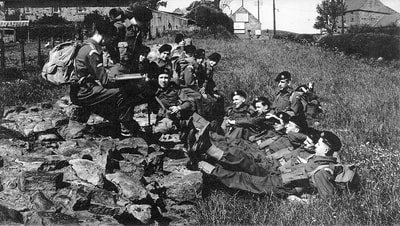Although the current Church of St. Mary the Virgin, adjacent to and inline with the Priory, mainly stems from the 12th and 13th centuries, it was considered to be the oldest building on Holy Island from previous observations by Peter Ryder.
He had shown that the building combines stone-work from the Saxon period. Removal of internal plaster had revealed parts of a round-headed Saxon arch touching the later Early-English arch in the wall that divides the nave from the chancel. High above this is a typical Saxon ‘door’.
On the outside of the building where the nave joins the chancel, long and short quoins are seen, typical of the Saxon period. It had been considered that some of these stones could be from the church that was built around St Aidan's original wooden church which dated from his arrival on the island in 635 AD.
Here were found the foundations of a stone building in a location shown on a plan in unpublished work by Hope-Taylor in 1962.
The dig revealed sandstone blocks a metre long, foundations of more than metre wide, a probable altar base and the division between the nave and the chancel.
Peter Ryder, who was recording the dig, said that the building was 'very likely' to have resembled the Seventh Century church which can be seen at Escomb in County Durham and may have been built to commemorate where St Aidan’s wooden church stood,
Apart from some roughly carved stone-work there were few datable finds although radiocarbon dates are still awaited from a small amount of charcoal.
To the West of the chapel, close to the existing war memorial, further investigation was carried out on the remains of a substantial stone-built platform structure partially uncovered in 2016, which has been tentatively identified as the base of a tower, again possibly of Anglo-Saxon date. Mortared into the south face of the platform structure, which consisted of a single course of rough cobbles, the excavators discovered a socketed stone, thought to be a reused stone cross-base, and an external surface of small rounded cobbles in the same area. The presence of a cross-base suggests the possibility that the platform feature may have originally been the site of a ceremonial cross.
The Lantern Chapel, at the west end of The Heugh, was also investigated. This has been a poorly understood building and, in its current form, bears little resemblance to a chapel, although a chapel-like structure is depicted in this position on a map of the island dating from 1548. Excavation here seems to have confirmed the existence of this chapel by uncovering the footings of an east-west wall sitting directly upon the natural bedrock, apparently the remains of an older, narrower building on an east-west axis beneath the visible walls. A grave had been cut into the bedrock within the chapel and the disturbed remains of several individuals were found above it, but left undisturbed.
Although the dates of construction and use of the three major structures excavated on The Heugh in 2017 remain unclear, it is likely that they represent a long period of sacral activity and it is hoped that the analysis of samples taken from all three sites will provide significant additional information in the coming months.
Archaeologists’ dig reveals ancient Lindisfarne church - Church Times, 7th July 2017.
Archaeology The Heugh Final Press Release July 2017 - Peregrini Lindisfarne Landscape Partnership.












 RSS Feed
RSS Feed
